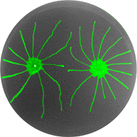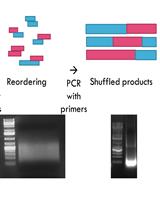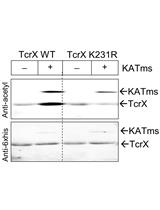- EN - English
- CN - 中文
ARP2/3 Phosphorylation Assay in the Presence of Recombinant Bacterial Effectors
重组细菌效应子存在条件下ARP2/3磷酸化修饰的检测
发布: 2017年04月05日第7卷第7期 DOI: 10.21769/BioProtoc.2208 浏览次数: 8847
评审: Yurong XieTatsuki KunohAnonymous reviewer(s)
Abstract
The Actin-Related Protein 2/3 (ARP2/3) complex is an actin nucleator that generates a branched actin network in mammalian cells. In addition to binding nucleation promoting factors, LeClaire et al. demonstrated that its phosphorylation state is essential key for its activity (LeClaire et al., 2008). In cells, the ARP2/3 complex is phosphorylated on threonine and tyrosine residues of the ARP2, ARP3, and ARPC1 subunits (Vadlamudi et al., 2004; LeClaire et al., 2008; Narayanan et al., 2011; LeClaire et al., 2015). In particular, phosphorylation of threonine 237 and 238 of the ARP2 subunit is necessary to allow a change in the ARP2/3 complex structure to its active conformation (Narayanan et al., 2011; LeClaire et al., 2015). While important for many functions in eukaryotic cells, ARP2/3 complex activity also benefits several cellular pathogens (Haglund and Welch, 2011; Welch and Way, 2013). Recently, we demonstrated that the bacterial pathogen, Legionella pneumophila, manipulates ARP2/3 complex phosphorylation state using a bacterial protein kinase injected in host cell cytoplasm (Michard et al., 2015). Here, we describe how to test the ability of a bacterial protein kinase or another protein kinase to phosphorylate the ARP2/3 complex in an in vitro context. First, the ARP2/3 complex and the bacterial protein kinase are produced and purified. Then, the purified proteins are incubated in the presence of ATP, and the ARP2/3 phosphorylation level is analyzed by Western blot.
Keywords: in vitro phosphorylation assay (体外磷酸化测定)Background
The ARP2/3 complex is phosphorylated on threonine and tyrosine residues (LeClaire et al., 2008). Four phosphorylation sites on the ARPC1 and ARP2 subunits of ARP2/3 complex are currently known: the threonine 21 of ARPC1, threonines 237/238 and tyrosine 202 of ARP2, each demonstrating an important role for ARP2/3 function (Vadlamudi et al., 2004; LeClaire et al., 2008; Narayanan et al., 2011). A recent study by our laboratory demonstrated that the Legionella kinase 2 (LegK2), an effector serine/threonine protein kinase of Legionella pneumophila, modifies the threonine phosphorylation state of ARPC1B and ARP3 subunits of ARP2/3 complex. ARP2/3 complex phosphorylation inactivates and blocks actin polymerization on the bacterial vacuole, preventing the degradation of bacteria by the endocytic pathway (Michard et al., 2015). This protocol describes an in vitro phosphorylation assay routinely used in our laboratory to test a potential substrate of protein kinases as subunits of the ARP2/3 complex. The protocol can be also adapted to assay other substrates as needed.
Materials and Reagents
- Overproduction and extraction of bacterial protein kinase
- 50 ml conical tubes (Greiner Bio One International, catalog number: 227261 )
- Sterile culture tubes (SARSTEDT, catalog number: 62.515.006 )
- Sterilization filters (0.22 µm) (Dutscher Scientific, catalog number: 51732 )
- Spectrophotometer cuvette (Dutscher Scientific, catalog number: 030101 )
- Escherichia coli BL21 (pREP4-groESL) (Amrein et al., 1995)
- pGEX-6P-3 (Smith and Johnson, 1988)/pGEX-protein kinase
- Prechilled dH2O
- Protease inhibitor cocktail (Sigma-Aldrich, catalog number: P8340 )
- LB medium (Lennox) (Carl Roth, catalog number: X964 )
- Ampicillin (Carl Roth, catalog number: K029 )
- Kanamycin (Sigma-Aldrich, catalog number: K4000 )
- Isopropyl β-D-1-thiogalactopyranoside (IPTG) (Carl Roth, catalog number: 2316 )
- Sodium chloride (NaCl) (Carl Roth, catalog number: 3957 )
- Potassium chloride (KCl)
- Sodium phosphate dibasic (Na2HPO4)
- Potassium phosphate monobasic (KH2PO4)
- LB medium + ampicillin + kanamycin
- LB medium (see Recipes)
- 100 µg/ml ampicillin (see Recipes)
- 25 µg/ml kanamycin (see Recipes)
- LB medium (see Recipes)
- 0.1 M IPTG (see Recipes)
- 1x phosphate-buffered saline (PBS) (see Recipes)
- 50 ml conical tubes (Greiner Bio One International, catalog number: 227261 )
- Purification of bacterial protein kinase
- Microtubes
1.5 ml (SARSTEDT, catalog number: 72.690.001 )
2 ml (SARSTEDT, catalog number: 72.694.006 ) - Polypropylene columns 1 ml (QIAGEN, catalog number: 34924 )
- Spectra/Por® dialysis membrane MWCO: 3.5-5 kD (Biotech CE Trial Kit) (Spectrum, catalog number: 131201T ), stored at 4 °C in humid atmosphere
- Protino Glutathione agarose-4B (Macherey-Nagel, catalog number: 745500.10 ), stored at 4 °C
- Glycerol (Carl Roth, catalog number: 3783 )
- Tris(hydroxymethyl)aminomethane (Tris) (Carl Roth, catalog number: 5429 )
- Glutathione (Sigma-Aldrich, catalog number: G4251 )
- Sodium chloride (NaCl) (Carl Roth, catalog number: 3957 )
- 1x PBS (see Recipes)
- GST elution buffer (see Recipes)
- Dialysis buffer (see Recipes)
- Microtubes
- Purification of ARP2/3 complex
- Polypropylene columns 1 ml (QIAGEN, catalog number: 34924 )
- PD-10 columns (GE Healthcare, catalog number: 17085101 )
- Actin-depleted cellular lysates prepared from Acanthamoeba castellanii (Zuchero, 2007)
- Liquid nitrogen (liquid N2)
- Tris (Fisher Scientific, catalog number: BP152-5 )
- Magnesium chloride (MgCl2) (Fisher Scientific, catalog number: BP214-500 )
- 4-(2-hydroxyethyl)-1-piperazineethanesulfonic acid (HEPES) (Fisher Scientific, catalog number: BP2939100 )
- Dithiothreitol (DTT) (Fisher Scientific, catalog number: BP172-5 )
- Glycerol (Fisher Scientific, catalog number: P2294 )
- Potassium chloride (KCl) (Fisher Scientific, catalog number: P217-500 )
- Adenosine triphosphate (ATP) (Fisher Scientific, catalog number: BP413-25 )
- N-WASP VCA-coupled-CH-Sepharose (Zuchero, 2007)
- Phenyl Sepharose (Sigma-Aldrich, catalog number: P2459 )
- Buffer A (see Recipes)
- ARP2/3 elution buffer (see Recipes)
- ARP2/3 storage buffer (see Recipes)
- Polypropylene columns 1 ml (QIAGEN, catalog number: 34924 )
- Dephosphorylation of ARP2/3 complex
- Microtubes (1.5 ml)
- 3,500 MWCO Mini dialysis units (Thermo Fisher Scientific, Thermo ScientificTM, catalog number: 69550 )
- 2 mM Tris, pH 8.0 (Fisher Scientific, catalog number: BP152-5 )
- Antarctic phosphatase (New England Biolabs, catalog number: M0289 )
- N-WASP VCA-coupled Sepharose (Zuchero, 2007)
- Tris (Fisher Scientific, catalog number: BP152-5 )
- dH2O
- Magnesium chloride hexahydrate (MgCl2) (Fisher Scientific, catalog number: BP214-500 )
- Zinc chloride (ZnCl2) (Sigma Aldrich, catalog number: Z3500 )*
- 5x HipH buffer (see Recipes)
- Buffer A (see Recipes)
- ARP2/3 elution buffer (see Recipes)
- Microtubes (1.5 ml)
- In vitro phosphorylation assays
- Microtubes (1.5 ml) (SARSTEDT, catalog number: 72.690.001 )
- Purified bacterial kinase and its catalytic variant
- Purified and purified/dephosphorylated ARP2/3 complex
- Tris (Carl Roth, catalog number: 5429 )
- Manganese chloride (MnCl2) (Fisher Scientific, catalog number: M87-100 )
- DTT (Carl Roth, catalog number: 6908 )
- ATP (Sigma-Aldrich, catalog number: A5394 )*
- dH2O
- Magnesium chloride hexahydrate (MgCl2) (Carl Roth, catalog number: 2189 )
- Zinc chloride (ZnCl2) (Sigma-Aldrich, catalog number: 211273 )
- Sodium dodecyl sulfate (SDS) (Carl Roth, catalog number: 2326 )
- Glycerol (Carl Roth, catalog number: 3783 )
- Bromophenol blue (Sigma-Aldrich, catalog number: B6131 )*
- β-mercaptoethanol (Sigma-Aldrich, catalog number: O34461-100 )
- Antarctic phosphatase (New England Biolabs, catalog number: M0289 )
- 10x phosphorylation buffer (see Recipes)
- ATP solution at 0.5 mg.ml-1 (see Recipes)
- 5x Laemmli loading buffer (see Recipes)
- 5x HipH buffer (see Recipes)
- Microtubes (1.5 ml) (SARSTEDT, catalog number: 72.690.001 )
- Detection of phosphorylation level with Western Blot
- Square Petri dish (Greiner Bio One International, catalog number: 688162 )
- Whatman 3 MM CHR paper (GE Healthcare, catalog number: 3030-917 )
- Nitrocellulose membrane Optitran BA-S85 reinforced NC (GE Healthcare, catalog number: 10439194 )
- 50 ml conical tubes
- Parafilm
- Plastic wrap
- Page RulerTM prestained protein ladder (Thermo Fisher Scientific, Thermo ScientificTM, catalog number: 26616 )
- Monoclonal mouse anti-phosphothreonine antibody, Clone PTR-8 (Sigma-Aldrich, catalog number: P6623 )
- Goat anti-mouse IgG peroxidase antibody (Sigma-Aldrich, catalog number: A0168 )
- Super Signal West Pico Chemiluminescent Substrate (Thermo Fisher Scientific, Thermo ScientificTM, catalog number: 34080 )
- Rotiphorese Gel 30 (30% acrylamide, 0.8% bisacrylamide) (Carl Roth, catalog number: 3029 )
- Tris (Carl Roth, catalog number: 5429 )
- dH2O
- SDS (Carl Roth, catalog number: 2326 )
- Ammonium persulfate (APS) (Carl Roth, catalog number: 9592 )
- Tetramethylethylenediamine (TEMED) (Carl Roth, catalog number: 2367 )
- Glycine (Carl Roth, catalog number: 0079 )
- Glacial acetic acid
- Ethanol
- Coomassie Brilliant Blue R-250 (MP Biomedicals, catalog number: 1-800-854-0530 or MP Biomedicals, catalog number: 02190682 )
- Methanol
- 6-aminohexanoic acid
- Sodium chloride (NaCl) (Carl Roth, catalog number: 3957 )
- Bovine serum albumin (BSA) (Carl Roth, catalog number: T844 )
- Tween 20 (VWR, BDH®, catalog number: 663684B )
- Anti-phosphotyrosine antibody (EMD Millipore, catalog number: AB1607 )
- Migration buffer (see Recipes)
- 12% SDS-PAGE gels (see Recipes)
- Staining solution (see Recipes)
- Destaining solution (see Recipes)
- Assembly for the semi-dry transfer
a.Transfer solution 1 (see Recipes)
b.Transfer solution 2 (see Recipes)
c.Transfer solution 3 (see Recipes) - Tris-buffered saline (TBS) (see Recipes)
- TBS-5% BSA (see Recipes)
- TBS-0.1% Tween 20 (see Recipes)
- Anti-phosphothreonine antibodies solution (see Recipes)
- Anti-mouse-peroxydase antibodies solution (see Recipes)
- Square Petri dish (Greiner Bio One International, catalog number: 688162 )
*Note: These products have been discontinued.
Equipment
- Shaker/incubator at 37 °C and 20 °C for tubes and 500 ml Erlenmeyer flask
- Autoclave
- Ultrospec 10-cell density meter (GE Healthcare, Amersham Biosciences, model: Ultrospec® 10 )
- Centrifuges for conical and microtubes at 4 °C
- French pressure cell press (American instrument company)
- Tubes rotator for conical and microtubes
- Support of purification columns
- NanoDrop 2000 spectrophotometer (Thermo Fisher Scientific, Thermo ScientificTM, model: NanoDropTM 2000 )
- Freezer -80 °C
- Lab water bath at 37 °C and 30 °C
- Dry block heater at 100 °C
- HoeferTM Dual Gel Caster system (GE Healthcare, Amersham Biosciences, model: Dual Gel Caster )
- Electrophoresis power supply
- Semi-dry blotter (C.B.S Scientific, catalog number: EBU-4000 ) with GD3000 D generator (Sebia)
- ChemiStart 5000 (Fisher Bioblock Scientific)
Procedure
文章信息
版权信息
© 2017 The Authors; exclusive licensee Bio-protocol LLC.
如何引用
Michard, C., LeClaire, L. L. and Doublet, P. (2017). ARP2/3 Phosphorylation Assay in the Presence of Recombinant Bacterial Effectors. Bio-protocol 7(7): e2208. DOI: 10.21769/BioProtoc.2208.
分类
微生物学 > 微生物生物化学 > 蛋白质 > 修饰
细胞生物学 > 细胞运动 > 细胞运动性
生物化学 > 蛋白质 > 修饰
您对这篇实验方法有问题吗?
在此处发布您的问题,我们将邀请本文作者来回答。同时,我们会将您的问题发布到Bio-protocol Exchange,以便寻求社区成员的帮助。
提问指南
+ 问题描述
写下详细的问题描述,包括所有有助于他人回答您问题的信息(例如实验过程、条件和相关图像等)。
Share
Bluesky
X
Copy link













